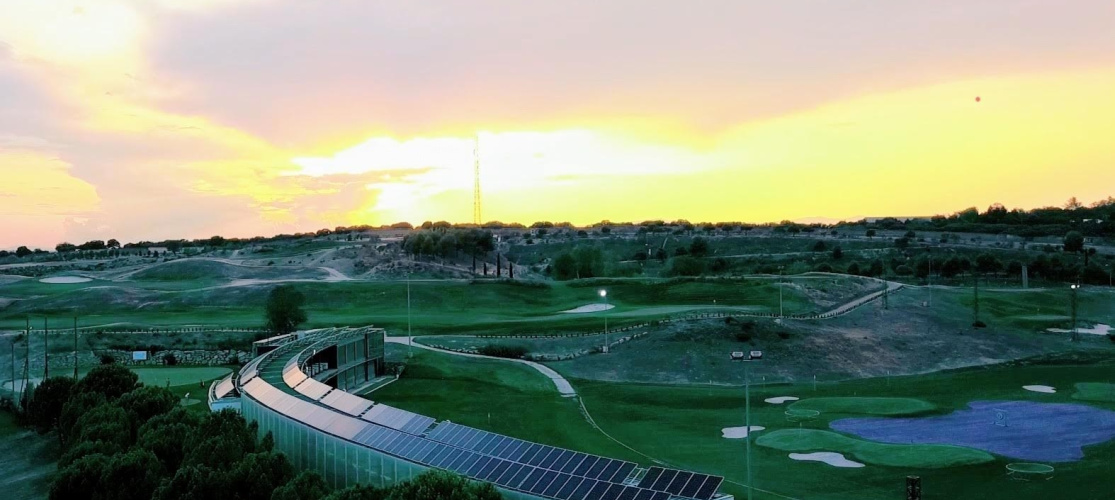

THE R&A AND RFEGOLF WORKING TOGETHER TO MAKE GOLF MORE SUSTAINABLE With Solar Power
David Gómez Agüera - david.gomez@rfegolf.es
On 14 August 2019, at the Royal Spanish Golf Federation National Golf Centre, a pioneering project was set in motion which you are sure to hear a lot about in the near future.
To be more specific, the project involves the design and construction of a 95 kWp solar photovoltaic power installation for self-consumption, whose aim is to reduce the centre’s electricity costs via the generation of a significant part of the electricity needs through its own resources.
This electric power generation is exclusively achieved through the use of renewable energy sources, in this case, by transforming solar radiation into electricity via the photovoltaic effect. This energy source is 100% renewable and its use involves no burning of fossil fuels or production of emissions, does not contribute to the greenhouse effect or have any other harmful effect. Moreover, 100% of the plant is installed on the roofs of pre-existing buildings and facilities, so it is not necessary to take up new space, but rather the installation will be situated in places otherwise not exploited or of no real useful value.
This project was developed by the R&A Sustainability Fund together with the Royal Spanish Golf Federation in their commitment to make golf more sustainable. The R&A will be analysing the impact of the project, with the goal of promoting it as an example of sustainable environmental and economic practice to other golf courses around the world.
Image: Installation of photovoltaic solar panels on the roof of the practice range of the Royal Spanish Golf Federation National Golf Centre. The panels are arranged on a sloping structure with counterweights in such a way that is not necessary to drill holes in the roof of the building and the generation of energy is maximised by having the solar panels set out on a virtually horizontal roof.
During the period of exploitation, the solar photovoltaic power installation will generate electricity continuously depending on the amount of incident light radiation from the sun over the course of the day, which will vary depending on the time and the weather conditions at any given moment. The electrical power generated will not be stored, but rather fed directly into the internal electrical grid for subsequent distribution to the centres of consumption which are run off this energy (mainly the pumps of the sprinkler systems and the clubhouse’s own services, the practice range and the high performance centre.
Image: record of generation vs. demand for the internal consumption of solar photovoltaic power on 29/09/2019 at the plant at the Centro de la Real Federación Española de Golf. In light green the curve for the demand and in dark green the solar generation. The ratio of internal consumption achieved on this day is 23.8%, that is, a quarter of the energy that the golf course required.
The adjustment of the size of the installation has been made to avoid the production of surplus energy (energy generated which is surplus to the demand at a particular moment) thereby optimising its investment/return ratio.
Another of the big advantages of this kind of project is that their operation and exploitation do not require the intervention of centre staff in any way, since these plants are fully monitored and controlled remotely and in addition have a central alarm system of their own which allow continuous and accurate monitoring of the operating status of all the installed equipment.
The plant is predicted to generate 154,423 kWh of electricity per year, the equivalent of the annual consumption of 20 homes. This power will be virtually totally used for the reduction of the demand for electricity by the centre from the conventional grid, representing a saving in electricity costs of a minimum of 21.4%. Furthermore, the generation of this energy using renewable sources will allow greenhouse gas emissions to be reduced by 57.68 tonnes of CO2 per year that the plant is in operation (the working life of these plants can be over 30 years), which is the equivalent of the benefits of a small forest consisting of 114 fully-grown trees.
Barely a month and a half after it started operating, this plant has already generated practically 13% of its annual target and, in practice, a reduction of 22% in the demand for electricity from the conventional grid.
The aim of this project, when all is said and done, is to serve as an example for the rest of the golf courses in Spain to show them that investing in reducing their environmental impact not only reduces energy consumption, but also improves their bottom line.
The installation has been designed and carried out by the ARESOL group, one of the longest standing business groups in the renewable energy sector in Spain with over 38 years’ experience, as well as a long list of plants installed and currently producing power. The ARESOL Group takes care of the design and the adaptation of the size of the installation, its construction and commissioning, all the paperwork involved in legalising it and its ongoing care and maintenance.

